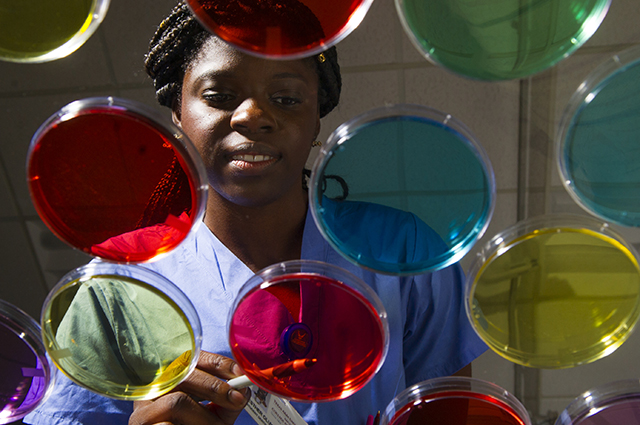What’s on the inside counts

TAMBCD student’s research compares color stability of endodontic materials, gleans national honors
In today’s world of modern dentistry, endodontic treatments such as root canals and vital pulp therapies can breathe new life into a tooth that otherwise might be lost. There’s just one problem: Certain materials used in these procedures can cause discoloration of the teeth, most often to an undesirable shade of gray or even blue. Since these materials are packed inside the tooth, the darkened hue shines through the enamel. The only way to get rid of it is to bleach the tooth or cover it with a crown, but that only works in permanent teeth.
It’s an issue that Esther Oluwo, a third-year student at Texas A&M University Baylor College of Dentistry, understands well. She spent most of summer 2014 testing the color sustainability of several products used in these procedures. The findings were telling; they recently earned her first place in the 2015 Student National Dental Association scientific poster competition during the July annual session of the group’s professional counterpart — the National Dental Association.
Oluwo, a participant in the Predoctoral Research Training Fellowship program at TAMBCD, spent the course of several weeks meticulously examining pellet-size portions of some of the most commonly-used root and pulp treatment materials on the market today: Biodentine, White ProRoot MTA, and bioceramics MTA Plus and NeoMTA Plus. She then exposed those samples to substances commonly found in the mouth, like saliva and blood, as well as compounds used in clinical procedures, such as sodium hypochlorite — bleach — used to irrigate a tooth after removing damaged pulp tissue, and formocresol, which is commonly used in primary teeth pulpotomies.
“We wanted to find out what was causing the teeth to change color and out of all the materials, which one changes color the least,” explains Oluwo.
Findings revealed significant darkening in the presence of formocresol, which gives dentists an immediate takeaway to avoid this substance in combination with the tested endodontic materials. Other materials showed varying discoloration in combination with substances like saliva and saline.
“This is clinically relevant because now clinicians can make more informed decisions when treating patients,” Oluwo says. “The dentist can look at the materials and compare to determine which one they would like to use to treat their patients.”
Next steps, Oluwo suggests, could include looking at how much of the culprit materials it takes to cause discoloration.

Her research builds upon multiple projects at the college evaluating color stability of current and emerging endodontic materials. It’s a hot topic, as response to the research has been strong: Oluwo won first place in the TAMBCD Research Scholars Day dental student poster competition this spring and will present at the Hinman Student Research Symposium in the fall.
Dr. Lynne Opperman, professor and director of the Office of Technology Development, served as faculty mentor for the project and says research opportunities like Oluwo’s offer an added benefit for students.
“It’s a really good experience for students to understand product development when as clinicians they get a sheet saying, ‘I’ve got this great, fabulous new material,’ and determine whether great experiments were done, or not so great experiments,” Opperman says. “It allows them to understand the process and critically assess the work done on those materials.”